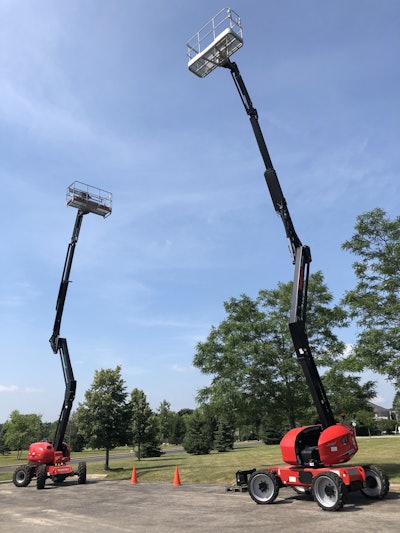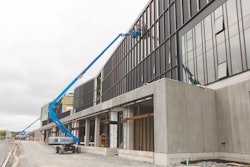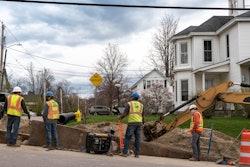
New standards governing aerial work platforms that have been years in the making and faced numerous delays went into effect June 1.
The A92 standards approved May 7 by the American National Standards Institute Board of Standards Review will change most aspects of how aerial lifts are made, used and maintained in the United States. The standards even give the lifts a new name: “mobile elevating work platforms.” So be prepared to hear the word “mewps,” the sounded-out MEWPs acronym.
The ANSI standards govern all telescopic boom, articulated boom and scissor lift aerial work platforms built on or after June 1. Telehandlers and trailer- and truck-mounted cranes are not included. MEWPs built before the standards took effect are grandfathered in, so they won’t have to be retrofitted to the new design standards. However, new standards on safe use and training will apply to all MEWPs regardless of their age.
The biggest change for contractors will be the standards’ call for all MEWP operators and their supervisors to be trained to the new safety standards. Much of the training can be taken online for operators, but there is a machine demonstration portion required. Supervisors are not required to perform an in-person demonstration and can receive all of their training online.
The standards also call for contractors to develop comprehensive safe-use programs for all MEWPs on a jobsite. The program must be documented and all personnel trained on it before MEWP operations can begin. The program must include a site risk assessment to identify hazards, implement hazard controls, alert all those affected on the jobsite about the hazards, among other issues. Contractors will also need to develop a written rescue plan and train personnel on it.
Another major part of the standards involves the machines. Manufacturers must now integrate specific safety features, such as load-sensing technology that cuts off the lift to prevent platform overload, on aerial lifts built on or after June 1. Most manufacturers have rolled out new ANSI-compliant lifts ahead of the standards’ effective date.
The Association of Equipment Manufacturers praised the new standards’ approval as finally providing clarity on machine compliance.
“Equipment manufacturers have been working in limbo for years, ensuring that their equipment meets current standards, all while preparing for the changes in the new version to be published,” said AEM Director of Product Stewardship Jeff Jurgens. “They are now ready to move forward with clear direction.”
What now?
Starting June 1, MEWP operators and their supervisors need to be trained, and safe-use plans need to be in place when operating MEWPs to be in compliance with the new standards.
The standards are voluntary. But industry experts say that noncompliance could place contractors in legal jeopardy should an accident occur. The Occupational Safety and Health Administration could also cite a contractor under its General Duty Clause for not using industry best practices, when on a jobsite investigating an incident.
“Regarding them being voluntary, how can you support being compliant with OSHA’s employer requirement to provide a workplace free from harm if you are not following industry best practices?” Tony Groat, North American regional manager for the International Powered Access Federation, said in an email to Equipment World. “I guarantee every plaintiff’s attorney will be ready to refer to the standards!”
The standards were published in December 2018 with the intent to allow the industry time to comply by their original effective date of December 2019. Appeals led to delays, with the effective date moved to June 1.
Despite the year and a half lead time on the effective date and the years of discussions on the standards, Groat doubts the industry as a whole is ready for them.
Some will be ready, but some are also waiting for the actual start of the standards before getting ready to comply. Many will not comply because they are voluntary, he says.
“There has been more industry conversation about these standards for a longer period of time than any other standards and yet many will not be prepared to follow these industry best practices,” he says.
Pandemic makes training a challenge
For those who aren’t prepared, Groat recommends they “read and understand their responsibilities, create a plan setting reasonable priorities, and implement the plan.”
Industry experts can help, with information available on the websites of IPAF, MEWP manufacturers and large rental companies. He notes that IPAF has a white paper that outlines the standards’ key changes and how they impact users.
The pandemic will make getting training more of a challenge. Some training organizations have temporarily closed, and some rental companies stopped offering training at their facilities because of the pandemic, Groat says. “Much training was halted as nonessential business. Things are starting to open up, but immediately there will likely be challenges in getting training scheduled.”
IPAF offers Powered Access License Cards (PAL Cards) that operators can use to show they have received proper training on the standards. IPAF has extended the amount of time required between online training and the mandatory practical assessment to 90 days to accommodate the need for social distancing. Those who have a PAL Card that is about to expire may be able to get an extension on the expiration date under special measurers, IPAF says. The association also recently held a webinar on safe MEWP training and operations in the pandemic, which can be downloaded here.
Groat cautioned those seeking training to be certain it meets the new ANSI standards.
“I have seen training that claims to be OSHA approved – and OSHA doesn’t approve anything,” he says. “Just because someone states they meet the training requirements is not a guarantee it actually does. Ensure you are getting training from a source you can depend upon and do some verification on their training before you invest your time and money.”
Here are some other resources to help contractors comply with the new standards:
- JLG is offering online MEWP training for supervisors.
- Genie provides a variety of information on the new standards and has information on its training offerings.
- Skyjack has MEWP training programs.
Some controversy lingers
Though the new standards are set to take effect, some questions remain, particularly for the American Rental Association.
The ARA has filed several appeals to the standards, objecting to a requirement that each MEWP have a “manual of responsibilities.” The manual must contain certain definitions and A92 standards, be kept in weather-proof protection and maintained on each MEWP.
The manual will put a financial burden on the rental industry, ARA has said, and would have been published only by the Scaffold & Access Industry Association, which is also the secretariat for the ASC A92 Committee that developed the standards. The ARA argued that because the manual was published only by the SAIA, it violated ANSI policies that say its standards can’t endorse products with a sole source.
ARA won that appeal, and the revised standards drop the requirement for a specific manual of responsibilities, though an MoR is still required in some form, or its “equivalent.” But the ARA still has concerns. It has asked for further interpretation and plans to reserve its right to appeal to the ANSI Board of Standards Review, says John McClelland, the association’s vice president for government affairs and its chief economist.
“We think that the manual of responsibility is unnecessary, and that it doesn’t lead to safe outcomes,” McClelland says. “It’s a long complicated document that comes in English only and, frankly, that nobody reads.”
The manual could also become a liability problem for rental companies, says Kevin Gern, ARA’s director of safety.
“I can tell you that the manual of responsibilities is one of the No. 1 items that comes up in a court case,” Gern says.
He’s especially concerned about manuals for machines built before the standards’ effective date. He says it’s unclear whether using the machine’s original manual of responsibilities, which does not include the new standards, would comply or whether a new manual is required.
“Basically, you’re creating this liability to not allow rental companies to know what they should do in those types of situations,” he says. “So it creates this huge liability hole that eventually somebody’s going to get pulled into a court case on any given machine. And this MoR is going to be brought up, and it’s going to be used against them as to which version was on there, if any version was on there.”
McClelland says the manual requirement should be eliminated. He says ANSI standards on other construction equipment do not require such manuals, and it is only required to fund SAIA, which also publishes the ANSI standards for MEWPs and charges for them as well.
“The SAIA wants the rental industry to pay for them to continue as a viable operation,” McClelland says. “It’s purely a money play and has been a money play all these years.”
The SAIA, in its response to the ANSI Board of Standards Review on April 7 as the secretariat of the ASC A92 Aerial Platforms Committee, says the newly revised standards allow a manual of responsibilities or its equivalent to be created by any entity, not just the SAIA, and the manual is not required to have specific SAIA copyrighted material. “There is no requirement to purchase a manual of responsibilities product from SAIA in order to comply with the standard,” the response says.
It says a direct copying of the copyrighted standards for the manual would violate U.S. copyright law’s fair use doctrine, but the association would give ARA leeway. “The respondent believes that blatant copying of the standard verbatim would not be a fair use. However, SAIA has expressed to the Appellant, verbally and in writing, that a reasonable attempt to avoid a direct copy of the standards would not be challenged under its copyrights,” the response says.
SAIA also says that the copyrighted material it sells is used to fund its service as an ANSI-Accredited Standards Developer, which ANSI has supported. ANSI does not create standards, which are instead done by standards developer organizations (SDOs), which SAIA has been for 35 years.
“It is important to keep in mind that ANSI has long supported the ability of SDO’s to copyright the standards created by the organization to fund the administration of the ASC,” the response says.
Gern says the ARA is awaiting a written response from SAIA on its concerns and has been granted an extension to June 29 on filing an appeal to the ANSI Board of Standards Review.
How to obtain the new standards
Though appeals may occur, they will not delay the standards’ June 1 effective date, say industry experts.
The new standards are as follows, with links provided to how the standards can be purchased from SAIA:
- ANSI/SAIA A92.20-2020: Design, Calculations, Safety Requirements and Test Methods for Mobile Elevating Work Platforms (MEWPs)
- ANSI/SAIA A92.22-2020: Safe Use of Mobile Elevating Work Platforms (MEWPs)
- ANSI/SAIA A92.24-2018: Training Requirements for the Use, Operation, Inspection, Testing and Maintenance of Mobile Elevating Work Platforms (MEWPs)
The above standards replace the following standards:
- ANSI/SAIA A92.3-2006 (R2014) for Manually Propelled Elevating Aerial Platforms
- ANSI/SAIA A92.5-2006 (R2014) for Boom-Supported Elevating Work Platforms
- ANSI/SAIA A92.6-2006 (R2014) for Self-Propelled Elevating Work Platforms
- ANSI/SAIA A92.8-2006 (R2011) for Vehicle-Mounted Bridge Inspection and Maintenance Devices











